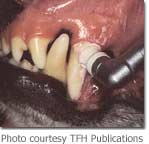|
Our cats are living longer now than in the past. Today, we have better preventive medicine (e.g., vaccinations and blood screening) and better ways to diagnose and treat many diseases. Now we are seeing more cats whose most severe medical problems are dental problems. To prevent oral disease, which is the number one health problem diagnosed in pets, it is essential to provide our pets with good dental care, both professionally and at home.
Dental disease in cats
Plaque: Cats rarely get cavities, but are much more prone to gum disease and excess tartar build-up on the teeth. Food particles and bacteria collect along the gumline forming plaque. Routine home care can remove this plaque.
 Tartar: If plaque is not removed, minerals in the saliva combine with the plaque and form tartar (or calculus) which adheres strongly to the teeth. Plaque starts to mineralize 3-5 days after it forms. The tartar is irritating to the gums and causes an inflammation called gingivitis. This can be seen as reddening of the gums adjacent to the teeth. It also causes bad breath. At this point it is necessary to remove the plaque with special instruments called scalers. Tartar: If plaque is not removed, minerals in the saliva combine with the plaque and form tartar (or calculus) which adheres strongly to the teeth. Plaque starts to mineralize 3-5 days after it forms. The tartar is irritating to the gums and causes an inflammation called gingivitis. This can be seen as reddening of the gums adjacent to the teeth. It also causes bad breath. At this point it is necessary to remove the plaque with special instruments called scalers.
Periodontal Disease: If the tartar is not removed, it builds up under the gums. It separates the gums from the teeth to form "pockets" and encourages even more bacterial growth. At this point the damage is irreversible, and called "periodontal" disease. It can be very painful and can lead to loose teeth, abscesses, and bone loss or infection. As bacterial growth continues to increase, the bacteria may enter the bloodstream. This can cause infection of the heart valves (endocarditis), liver, and kidneys. If treated by your veterinarian with special instruments and procedures, periodontal disease can be slowed or stopped.
What is included in a good dental care program?
A good dental care program includes:
- Regular visits to your veterinarian, which include an oral exam
- Veterinary dental cleaning as advised
- Daily home oral care
Oral Exams by Your Veterinarian: A thorough dental exam can identify potential problems such as plaque and tartar buildup, gingivitis, periodontal disease, and fractured or abscessed teeth. During an oral exam your veterinarian will:
- Examine the face and head for asymmetry, swelling, or discharges.
- Examine the oral cavity, oral mucosa, and surfaces of teeth and gums.
- Open the mouth to examine the inner surfaces of the teeth and gums and the tongue, palates, oral mucosa, tonsils, and ventral tongue area.
 Dental Cleaning by Your Veterinarian: To prevent dental disease, your cat needs routine dental care at home. But to perform good home care, you need to start with clean teeth. Brushing will remove plaque but not tartar. So if your cat's teeth have tartar, it is necessary for your veterinarian to remove it and polish the teeth. This professional veterinary dental cleaning is also called a prophylaxis or "prophy". A routine dental cleaning consists of: Dental Cleaning by Your Veterinarian: To prevent dental disease, your cat needs routine dental care at home. But to perform good home care, you need to start with clean teeth. Brushing will remove plaque but not tartar. So if your cat's teeth have tartar, it is necessary for your veterinarian to remove it and polish the teeth. This professional veterinary dental cleaning is also called a prophylaxis or "prophy". A routine dental cleaning consists of:
- Anesthetizing your cat and flushing the mouth with a solution to kill the bacteria.
- Cleaning the teeth with handheld and ultrasonic scalers. All calculus is removed from above and below the gumline.
- Using a disclosing solution to show any areas of remaining calculus which are then removed.
- Polishing the teeth to remove microscopic scratches.
- Inspecting each tooth and the gum around it for any signs of disease.
- Flushing the mouth, again, with an antibacterial solution.
- Recording any abnormalities or additional procedures on a dental chart.
- Determining the best follow-up and home dental care program for your cat.
Daily Home Oral Care: Home oral care includes routine examinations of your cat's mouth and brushing her teeth.
Home oral exam: As you care for your cat's mouth, look for warning signs of gum disease such as bad breath, red and swollen gums, a yellow-brown crust of tartar around the gumline, and pain or bleeding when you touch the gums or mouth. You should also watch for discolored, fractured, or missing teeth. Any bumps or masses within the mouth should also be checked by your veterinarian.
How long would you go without brushing your teeth?
Daily brushing: Regular brushing of your cat's teeth is a very important preventative for oral and other diseases. A step-by-step procedure for providing this care is found in our article Brushing Your Cat's Teeth.
Mechanical removal of plaque: Studies show that hard kibbles are slightly better at keeping plaque from accumulating on the teeth. There are veterinary dentist-approved foods on the market; one is t/d made by Hill's, the Science Diet people, and the other is Friskies Dental Diet. Research studies have shown that cats eating these foods have less plaque and tartar build-up.
What is ahead in the future?
Veterinary dentistry is becoming more common and more sophisticated. Pets can have the same procedures as people: root canals, crowns, and even braces. The Veterinary Oral Health Council is an organization of veterinary dentists who will help lead all of us in this rather new field. They have developed a seal of acceptance for pet dental products, just as the American Dental Association has its seal of approval. At this point the t/d diet and Friskies Dental Diet are the only feline products that have received the Veterinary Oral Health’s Council seal of acceptance. More studies are being done on other products. When they are proven to be effective through scientific studies, they will be eligible for approval.
© 2000 Drs. Foster and Smith, Inc.
Reprinted as a courtesy and with permission from PetEducation.com (http://www.PetEducation.com)
On-line store at http://www.DrsFosterSmith.com
Free pet supply catalog: 1-800-323-4208
|


